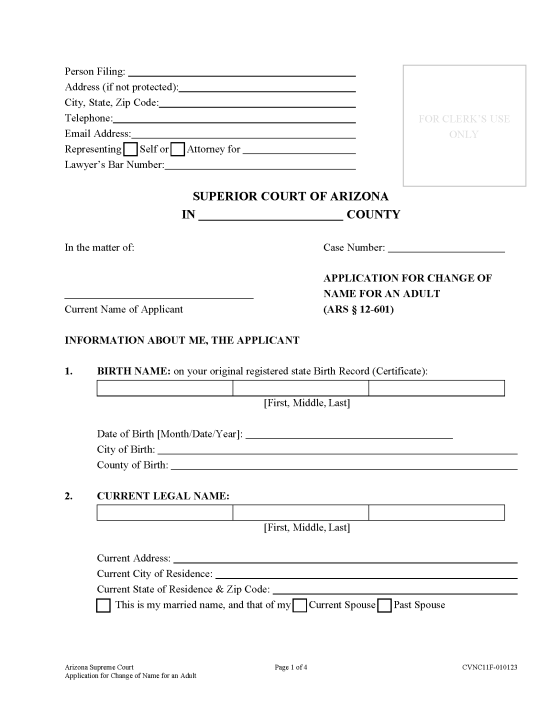Eligibility Requirements
- 18 years or older
- Resident of the county of filing
- Must be solely for the applicant’s best interests
- Cannot release the applicant from obligations or affect ownership rights
- Cannot be for committing or furthering criminal activity
Disclosure Requirements
Name change applicants must disclose if they have been convicted of a felony or have pending felony charges against them.[1]
How to Legally Change a Name in Arizona
Step 1 – Complete Application
Step 2 – File Forms
Step 3 – Notice of Hearing (if applicable)
If the court determines that third parties must be notified of the name change hearing, the applicant must send copies of the Application Form and Notice of Hearing to their spouse, ex-spouse, co-parent, creditors, prosecutors, or any other listed third parties 30 days before the hearing.[2]
Step 4 – Notify Spouse/Parent (if applicable)
If the applicant is required to notify their spouse or their child’s parent, the receiving parties must sign a Marital Waiver of Notice, Parental Waiver of Notice, or Acceptance of Service Form after receiving the name change forms. Which form applies depends on whether the spouse/parent consents to the applicant’s name change.
Step 5 – Notify Third Parties (if applicable)
If an applicant is required to notify third parties, they must do so by certified mail with a return receipt requested. Once the applicant receives the receipt, they can complete an Affidavit of Notice by Certified Mail and file both forms with the superior court clerk.
Step 6 – File Additional Forms
Before or at the time of the hearing, depending on the county, the applicant must provide the following forms:
- Clerk-stamped copies of all filed documents
- Order for Changing Name for an Adult
- Proof of notice (waivers, affidavits, etc.)
- Copy of photo ID
- Copy of birth certificate (if changing birth certificate name)
- Divorce Decree (if applicable)
- Prior Name Change Order (if applicable)
Step 7 – Court Hearing
If the applicant’s paperwork is in order, there are no objections, and the judge sees no reason for denial, the judge will complete the Order Changing Name for an Adult to officially legalize their name change.
Marriage and Divorce
To take someone’s name after marriage, a spouse can take an official copy of their marriage certificate to the Social Security Administration, DMV, passport office, and other institutions to update their IDs and licenses with their new name.
To revert to a previous name after divorce, a person can enter their current and previous names on the divorce paperwork. A certified copy of the Decree of Dissolution can then be used to update their name on documents such as their Social Security card, driver’s license, etc.[3]
Resources
Forms
- Civil Cover Sheet
- Application for Change of Name for an Adult
- Notice of Hearing Regarding Application for Change of Name
- Marital Waiver of Notice
- Parental Waiver of Notice
- Acceptance of Service
- Affidavit of Notice by Certified Mail
- Order Changing Name of an Adult
- Decree of Dissolution
Links

